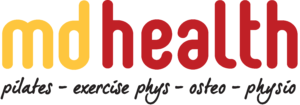We have been running Clinical and Personalised Pilates since 2003.
In the next few blogs, we are going to illustrate how and what type of Pilates will help with different clients and different scenarios…
The most common reason for Clinical Pilates is when someone has an injury. The most common is back pain, however, we see a range, including pelvic pain, neck pain, shoulder pain and knee pain to just scratch the surface, all which can be addressed with Clinical Pilates.
Again, to best demonstrate how Clinical Pilates works when you have an injury, will give an example with a fictional client
Clinical Pilates for Roger, 55 year old man, who has knee pain, which interferes with his weekly bike ride (Yes he does wear Lycra)
Roger is also a typical client that comes to see us to start Clinical Pilates to address a specific injury. Roger works as a partner in a large accounting firm and spends his weekends riding around the bay from St Kilda to Port Melbourne.
Roger has slowly developed knee pain over the last 6 months. Although it was originally there occasionally, it is now there after every ride and usually the next day. Roger also has difficult going down stairs. He occasionally gets back pain, but he is not really concerned about this and can deal with it
Where does the Clinical Pilates process start
As always, we start with a Full Body Assessment to find out the aims of his program and any major issues that we need to address during his program. Roger wants to
- Get rid of his knee pain
- Improve his cycling if possible
From Roger’s Full body Assessment, it was clearly determined that his pain was coming from patella-femoral joint pain (PFJ pain), due to poor tracking of his knee cap.
This occurs due to a number of factors, including weakness and slow contraction of the major stabiliser of the knee cap, the VMO muscle (Vastus Medialis Oblique), a particular portion of the quadriceps muscle.
Although Roger rides every weekend, his quadriceps are weaker than they should be for the activity that he undertakes. Other factors included pelvic instability and poor gluteal strength and control.
This has a major contributing factor to Roger’s knee pain as weakness in these muscles means more load on the quadriceps, which ultimately puts more strain on the PFJ.
Pelvic instability is probably the major cause of Roger’s back pain (Pelvic instability is very common during pregnancy, but is also very common in the general population due to muscle weakness). There were no other major concerns from his assessment
Roger’s Clinical Pilates Program
Roger began his 13 week Pilates program with a strong focus on improving the strength and control of this quadriceps and gluteal muscles. We assessed his core stability on ultrasound on the first day and surprisingly is was already very good (8 out of 12 on both sides).
We start with exercises demonstrating the correct contraction of the quadriceps and particularly the VMO portion. Roger gets to feel how the muscle should work and what the sensation should feel like.
We follow this with an exercise for the gluteal muscles and then return to exercises for the VMO. Again, we start simple and particular as we have a very direct goal for Roger’s program.
Over then next few weeks we continue to reinforce activation of the VMO muscle, but start progressing the load and weight in Roger’s Clinical Pilates exercises as strength is a major factor in reducing Roger’s knee pain.
At Roger’s week 7 re-assessment, Roger’s knee pain is better, but not gone. When he rides it hurts at the start, but does not continue and is not present the next day. His gluteal and quadriceps strength have improved significantly and VMO activation is much better.
However, we still need a bit more strength for Roger to achieve his goals. Pelvic instability is much better as Roger has much more gluteal strength and better activation.
In the next 6 weeks of Roger’s program, we again strongly focus on Roger’s strength. We progress to more complicated quadriceps and gluteal exercises, particularly focussed on eccentric strength of the muscles.
At Roger’s 13 week re-assessment, his knee pain is barely present. His gluteal and quadriceps strength is good and where it should be for bike riding. VMO and gluteal activation is now very good.
Roger even mentioned that the occasional back pain that was present no longer bothers him at all. Roger has also noticed that he finds riding easier and is a bit faster than his riding companions now.
Roger finishes our 13 week program and decides he want to continue the rest of his training at the gym on his own. We write an exercise program Roger can follow at the gym and he knows he can contact us if he needs help again
(Although this is a fictional example, this is a very typical example of our Pilates clients)


